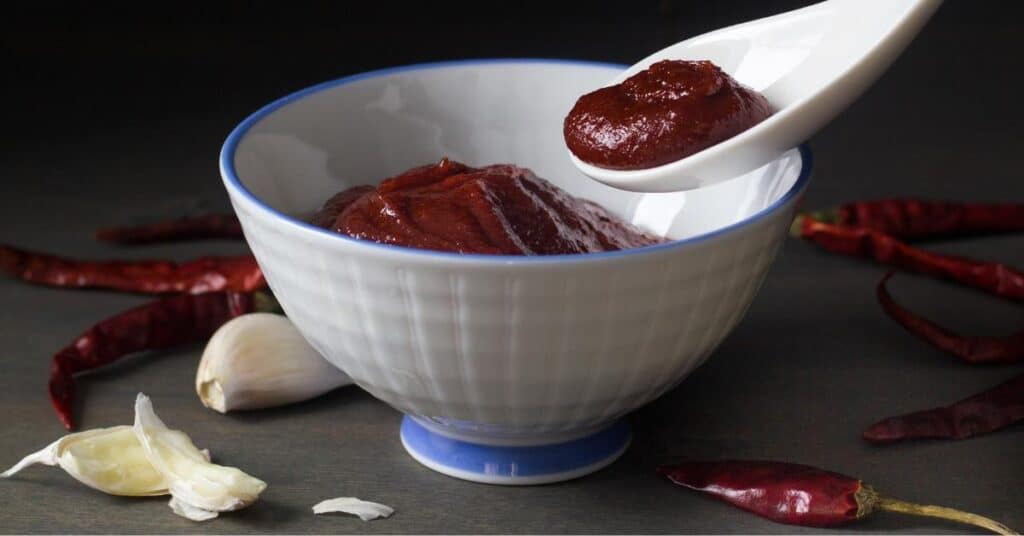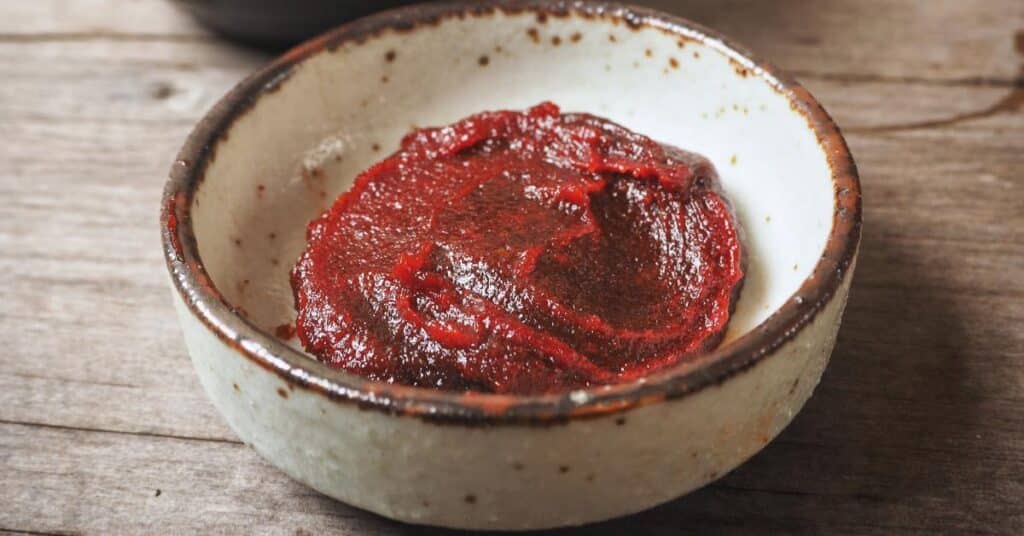
Gochujang is a popular Korean condiment known for its unique blend of spicy and sweet flavors and is often used in dishes like bibimbap, stir-fries, and marinades. It is something that you may not always have on hand, but there are a number of delicious substitutes for gochujang that we explore below.
What is Gochujang?
Gochujang is a popular Korean condiment made from fermented soybeans, glutinous rice, red chili pepper, and salt. This thick, red paste has a unique combination of spicy, sweet, and umami flavors. As one of the main ingredients of Korean cuisine, you’ll find it in dishes like bibimbap, tteokbokki, and bulgogi.
If you’re new to using gochujang, you should know that it can range in spiciness and sweetness levels. The heat level is often listed on the label, with a scale from 1 (mild) to 5 (very hot).
Korean Red Pepper Paste: The Primary Gochujang Substitute
Korean red pepper paste is the primary substitute for gochujang in recipes. You can easily find this paste in the international aisle of your local grocery store, at Asian markets, or even online. The paste comes in various levels of spiciness.
When using Korean red pepper paste as a gochujang substitute, start by using an equal amount in the recipe. You can always adjust the quantity to your liking, depending on the desired heat level. This paste is great for a wide variety of dishes, such as:
- Stews and soups: Add it to your favorite soups and stews to enhance their flavor and spiciness.
- Marinades: Mix Korean red pepper paste with soy sauce, garlic, and a sweetener of your choice to create a tasty marinade for meat and vegetables.
- Sauces: Use it as a base for making spicy dipping sauces, which pair well with fried or grilled dishes.
- Rice bowls and stir-fries: Mix the paste with your cooked rice or veggies to create a delicious, spicy stir-fry.
Sriracha
Sriracha, a popular Thai hot sauce, can be a good substitute for gochujang in many recipes. While both have a spicy kick, their flavors are distinct. Gochujang is savory, sweet, and spicy with a fermented undertone, while Sriracha has a tangy, garlicky spiciness. Although the taste difference is noticeable, using Sriracha instead of gochujang can still give your dishes a pleasant heat.
Sriracha has a thinner consistency than gochujang, so you might need to adjust the amounts used to achieve the desired thickness. In sauces and marinades, you can try mixing a tablespoon of Sriracha with a tsp of sugar to match the sweetness of gochujang.
In dishes like bibimbap or stews, Sriracha can be added to taste, depending on your preference for heat. Just keep in mind that the tangy flavor of Sriracha might slightly alter the overall taste of the dish.
Tomato Paste with Chili Flakes
To make a gochujang substitute using tomato paste and chili flakes, first gather your ingredients: tomato paste, red chili flakes, sugar, and soy sauce. Make sure you have a mixing bowl and a spoon or whisk for blending the ingredients together. If you’re concerned about spicy heat, you may adjust the amount of chili flakes to your liking.
Start by combining the tomato paste and chili flakes in the mixing bowl. Stir until the flakes are evenly distributed within the paste. This blend will give you the base flavor and spicy kick that resemble gochujang’s taste profile.
Next, add sugar and soy sauce to the mixture to balance the flavor and add a touch of umami. Mix everything thoroughly, ensuring all ingredients are well incorporated. Taste the mixture and adjust as needed to suit your preferences.
Here’s a simple recipe to make your tomato paste with chili flakes:
- 2 TBSPs tomato paste
- 1 TBSP red chili flakes
- 1 tsp sugar
- 1 tsp soy sauce
Feel free to adjust the ingredients based on your desired level of spice and sweetness. You can also try with different types of chili flakes or add other spices like garlic powder.
Other Gochujang Substitutes
Harissa
Harissa is a North African chili paste that can be a great substitute for gochujang. It’s made from roasted red peppers, spices, and herbs, giving it a complex and slightly smoky flavor. You’ll find it less sweet compared to gochujang, so you might want to add a little sugar or honey to balance the taste.
To replace gochujang in your recipes:
- Start with a 1:1 substitution ratio for spice level.
- Adjust the sweetness by adding sugar or honey to your liking.
Chipotle in Adobo Sauce
Another alternative to gochujang is chipotle peppers in adobo sauce. This smoky, deep-red Mexican sauce has a different flavor profile but will still bring a kick to your dishes. Made of smoked and dried jalapeños, the sauce also contains tomatoes, garlic, vinegar, and spices.
To use chipotle in adobo sauce as a gochujang substitute:
- Begin by adding one finely chopped chipotle pepper to your dish.
- Include 1-2 tsp of adobo sauce for extra flavor.
- Adjust the heat level by adding more peppers or sauce as needed.
FAQs

What can I use instead of gochujang for kimchi?
If you don’t have gochujang for kimchi, you can try using a mixture of red pepper flakes, soy sauce, and sugar. Combine 2 TBSPs of red pepper flakes, 1 TBSP of soy sauce, and 1 TBSP of sugar to create a paste similar to gochujang. Adjust the amounts to your taste.
Is there a gluten-free alternative to gochujang?
Yes, there are gluten-free alternatives to gochujang. You can look for gluten-free gochujang products in stores or online. Alternatively, you can create your own gluten-free gochujang substitute by combining gluten-free miso paste with red pepper flakes, sugar, and a bit of rice vinegar.
Can I replace gochujang with tomato paste or chili garlic sauce?
You can replace gochujang with a mixture of tomato paste and chili garlic sauce. To do this, mix equal parts of tomato paste and chili garlic sauce. This mixture will provide a similar spicy flavor but may lack the fermented, sweet undertones of gochujang.
How similar are gochujang and sambal oelek as substitutes?
Gochujang and sambal oelek are both spicy condiments, but they have different flavors. Gochujang is sweet and fermented, while sambal oelek is more savory and has a sharper heat. Although sambal oelek can be used as a substitute for gochujang, the taste may not be the same. You may need to adjust other ingredients in your recipe to balance the flavors.
What’s the difference between gochujang paste and sauce?
Gochujang paste is the traditional fermented Korean red pepper paste made from chili powder, glutinous rice, fermented soybean paste, and salt. Gochujang sauce, on the other hand, is a ready-to-use sauce variant of the paste, often thinned and sweetened, and may have vinegar or garlic.
Can I substitute gochujang with miso?
Miso can be used as a substitute for gochujang in a pinch, but it won’t provide the same spicy flavor. To mimic the spice and sweetness of gochujang, try mixing miso with red pepper flakes and a bit of sugar.
